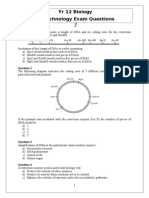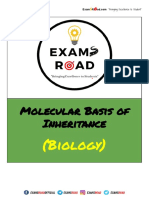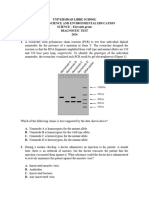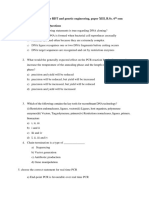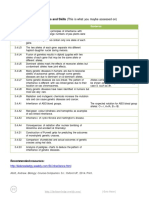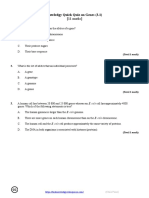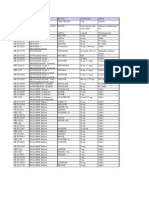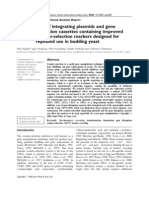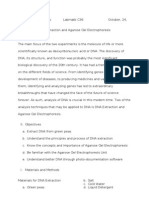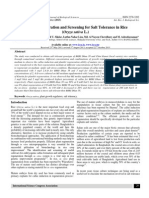Bioknowledgy Quick Quiz On 3.5 Genetic Modification and Biotechnology
Bioknowledgy Quick Quiz On 3.5 Genetic Modification and Biotechnology
Uploaded by
PineappleHeadCopyright:
Available Formats
Bioknowledgy Quick Quiz On 3.5 Genetic Modification and Biotechnology
Bioknowledgy Quick Quiz On 3.5 Genetic Modification and Biotechnology
Uploaded by
PineappleHeadOriginal Description:
Original Title
Copyright
Available Formats
Share this document
Did you find this document useful?
Is this content inappropriate?
Copyright:
Available Formats
Bioknowledgy Quick Quiz On 3.5 Genetic Modification and Biotechnology
Bioknowledgy Quick Quiz On 3.5 Genetic Modification and Biotechnology
Uploaded by
PineappleHeadCopyright:
Available Formats
BioK Quick Quiz on 3.
5 Genetic modification and biotechnology
BioKnowledgy Quick Quiz on 3.5 Genetic modification and biotechnology
[20 marks]
1.
Why can DNA profiling be used to determine paternity?
A.
Genes of children are exactly the same as their fathers.
B.
Half the genes of children are the same as their fathers.
C.
The father passes on all of his genes to each of his children.
D.
The father passes on a fraction of his genes equal to the number of his children.
(Total 1 mark)
2.
A small amount of a suspects DNA is obtained from a crime scene. What techniques would be used to
carry out DNA profiling?
A.
Gel electrophoresis and paternity testing
B.
Paternity testing and the polymerase chain reaction (PCR)
C.
Polymerase chain reaction (PCR) and gel electrophoresis
D.
Test crossing and pedigree analysis
(Total 1 mark)
3.
What type of enzyme could be used to cut a DNA molecule as indicated by the dotted line on the
diagram below?
A.
DNA ligase
B.
DNA polymerase
C.
Helicase
D.
Restriction enzyme
(Total 1 mark)
https://bioknowledgy.wikispaces.com/
(Chris Paine)
BioK Quick Quiz on 3.5 Genetic modification and biotechnology
4.
Which process is used in polymerase chain reaction (PCR)?
A.
Transcription
B.
Translation
C.
Replication
D.
Mutation
(Total 1 mark)
5.
Which processes involved in cloning an animal are indicated by the letters X and Y?
A.
differentiated cell removed from animal
nucleus removed from unfertilized egg
cell
B.
sex cell removed from animal
nucleus removed from differentiated
animal cell
C.
sex cell removed from animal
nucleus removed from unfertilized egg
cell
D.
differentiated cell removed from animal
nucleus removed from differentiated
animal cell
(Total 1 mark)
https://bioknowledgy.wikispaces.com/
(Chris Paine)
BioK Quick Quiz on 3.5 Genetic modification and biotechnology
6.
(a)
State the name of the technique that is used to separate fragments of DNA according to their
size, during DNA profiling.
......................................................................................................................................
(1)
(b)
The diagram below represents the results of a paternity investigation. Track A is the profile of
the mother of a child, track B is the profile of the child and track C is the profile of a man who
might be the father.
Explain, using evidence from the diagram, whether this man is the father or not.
......................................................................................................................................
......................................................................................................................................
......................................................................................................................................
......................................................................................................................................
......................................................................................................................................
......................................................................................................................................
......................................................................................................................................
(3)
https://bioknowledgy.wikispaces.com/
(Chris Paine)
BioK Quick Quiz on 3.5 Genetic modification and biotechnology
7.
(a)
Label the diagram below which shows a basic gene transfer.
I. ..................................................................................................................................
II. .................................................................................................................................
III. ................................................................................................................................
IV. ................................................................................................................................
(2)
(b)
State two general types of enzymes used in gene transfer.
......................................................................................................................................
......................................................................................................................................
(1)
https://bioknowledgy.wikispaces.com/
(Chris Paine)
BioK Quick Quiz on 3.5 Genetic modification and biotechnology
9.
Using a named example, discuss the benefits and harmful effects of genetic modification.
...................................................................................................................................................................
...................................................................................................................................................................
...................................................................................................................................................................
...................................................................................................................................................................
...................................................................................................................................................................
...................................................................................................................................................................
...................................................................................................................................................................
...................................................................................................................................................................
...................................................................................................................................................................
...................................................................................................................................................................
...................................................................................................................................................................
...................................................................................................................................................................
...................................................................................................................................................................
...................................................................................................................................................................
...................................................................................................................................................................
...................................................................................................................................................................
...................................................................................................................................................................
...................................................................................................................................................................
...................................................................................................................................................................
...................................................................................................................................................................
...................................................................................................................................................................
(8)
https://bioknowledgy.wikispaces.com/
(Chris Paine)
You might also like
- Quiz Medical GeneticsDocument43 pagesQuiz Medical GeneticsMedShare95% (20)
- Example IB Biology IADocument16 pagesExample IB Biology IAIB Screwed93% (153)
- Chapter 5 ProblemsDocument3 pagesChapter 5 Problemswalt richards0% (1)
- Bio 1002 B Mar FeedbackDocument13 pagesBio 1002 B Mar FeedbackLouise2880No ratings yet
- MC Chapter 21 TestDocument9 pagesMC Chapter 21 Testmjordan2012No ratings yet
- O Level Biology Practice Questions And Answers: Heredity And Molecular GeneticsFrom EverandO Level Biology Practice Questions And Answers: Heredity And Molecular GeneticsNo ratings yet
- International Pharmaceuticals Company Email IdDocument14 pagesInternational Pharmaceuticals Company Email IdDhananjaya ShettyNo ratings yet
- BioK IB QuestionsDocument14 pagesBioK IB Questionsvgf58jsq6cNo ratings yet
- 2014 Yr10 Biology Unit Test 2Document13 pages2014 Yr10 Biology Unit Test 2Zara Zalaal [Student]No ratings yet
- CH 5 CH 6 Quiz - 2Document5 pagesCH 5 CH 6 Quiz - 2Abir HerabNo ratings yet
- E4 - Ch1 - Test (Cloning and DNA Fingerprinting)Document6 pagesE4 - Ch1 - Test (Cloning and DNA Fingerprinting)Cloris WongNo ratings yet
- Bioknowledgy Quick Quiz On Dna Structure and Replication (7.1)Document3 pagesBioknowledgy Quick Quiz On Dna Structure and Replication (7.1)priyaNo ratings yet
- BIOT643 Midterm Exam Summer 2016Document4 pagesBIOT643 Midterm Exam Summer 2016JayNo ratings yet
- Genetic ChangeDocument4 pagesGenetic ChangeGeorge TarraNo ratings yet
- Biotechnology WorksheetDocument23 pagesBiotechnology WorksheetKellieThomson100% (4)
- AP Topic 10 Biotechnology and Developmental BiologyDocument65 pagesAP Topic 10 Biotechnology and Developmental BiologySursaj SinGhNo ratings yet
- Notes On Molecular Basis of Inheritance by ExamsRoadDocument8 pagesNotes On Molecular Basis of Inheritance by ExamsRoadVogolus machatteNo ratings yet
- Bio Topic 3 PracticeDocument15 pagesBio Topic 3 PracticeKarlina MikekNo ratings yet
- Mixed Questions Genetics1Document11 pagesMixed Questions Genetics1Abir OmarNo ratings yet
- Answerkey ExamI 13Document10 pagesAnswerkey ExamI 13waldo625No ratings yet
- Chapter 21 Genomes and Their EvolutionDocument8 pagesChapter 21 Genomes and Their Evolution蔡旻珊No ratings yet
- Which Response Describes The Behaviour of Chromosomes in Metaphase I and Anaphase II of Meiosis?Document6 pagesWhich Response Describes The Behaviour of Chromosomes in Metaphase I and Anaphase II of Meiosis?Alicia San JoseNo ratings yet
- Bioinformatics Assignment 4Document7 pagesBioinformatics Assignment 4likhonaNo ratings yet
- Exit Ticket 3.3Document5 pagesExit Ticket 3.3Yula JungNo ratings yet
- Recap Tut - Tut16 MicroDocument8 pagesRecap Tut - Tut16 Microappolliscr7No ratings yet
- Final Exam-Genetics Lab-Fall 2020-EmadDocument7 pagesFinal Exam-Genetics Lab-Fall 2020-Emadybnr7pgsbrNo ratings yet
- UntitledDocument8 pagesUntitledRobert FaganNo ratings yet
- Biology' 2024-25Document3 pagesBiology' 2024-25guysindoreNo ratings yet
- 2009 Biology - James Ruse Trial With SolutionsDocument47 pages2009 Biology - James Ruse Trial With SolutionszrlskfkxamtwrfxzlpNo ratings yet
- Diagnostic Test 11 CUL 2024Document4 pagesDiagnostic Test 11 CUL 2024ariannesdb123No ratings yet
- RDT and Genetic Engeneering, Paper XIII, B.Sc. 6th SemDocument4 pagesRDT and Genetic Engeneering, Paper XIII, B.Sc. 6th SemPhuong Lien LaiNo ratings yet
- Practice Test 2Document5 pagesPractice Test 2crazybobblaskeyNo ratings yet
- How To Use DNA Baser - 2 Minutes Video Tutorial - UrlDocument13 pagesHow To Use DNA Baser - 2 Minutes Video Tutorial - UrlThanga DuraiNo ratings yet
- Appendix D - Sample ExamDocument4 pagesAppendix D - Sample ExamshafferjfNo ratings yet
- Sample Test Questions 4Document12 pagesSample Test Questions 4api-242405009No ratings yet
- DNA PROFILING PracticeDocument8 pagesDNA PROFILING Practice2011050No ratings yet
- BT - 601Document4 pagesBT - 601PrincePiyushNo ratings yet
- Human GenomeDocument5 pagesHuman GenomeDebarshi SahooNo ratings yet
- 1090 F18 Midterm 35 MC V1-Answers - 2Document9 pages1090 F18 Midterm 35 MC V1-Answers - 2rachelhershoranNo ratings yet
- 2070 Mid Exam 1Document6 pages2070 Mid Exam 1Kwok AvishaNo ratings yet
- Molecular GeneticsDocument5 pagesMolecular GeneticsTrinh TrươngNo ratings yet
- IB Biology HL 2.6 WorksheetDocument10 pagesIB Biology HL 2.6 WorksheetKazeNo ratings yet
- Bio 2 Study GuideDocument17 pagesBio 2 Study GuideJahnik KurukulasuriyaNo ratings yet
- Access Genetics Essentials Concepts and Connections 3rd Edition Pierce Test Bank All Chapters Immediate PDF DownloadDocument43 pagesAccess Genetics Essentials Concepts and Connections 3rd Edition Pierce Test Bank All Chapters Immediate PDF Downloadzuridayeidi100% (3)
- Bio1a03 Practice Test 3Document10 pagesBio1a03 Practice Test 3QforQANo ratings yet
- CSIR Sample ProblemsDocument8 pagesCSIR Sample ProblemsRanjani KollurNo ratings yet
- Bioknowledgy Quick Quiz On Transcription & Gene Expression (7.2)Document2 pagesBioknowledgy Quick Quiz On Transcription & Gene Expression (7.2)priyaNo ratings yet
- CH 8Document13 pagesCH 8Qais Bani HaniNo ratings yet
- 1 Mark Questions: $QV 1 6LJPD FactorDocument19 pages1 Mark Questions: $QV 1 6LJPD FactorJames OrtegaNo ratings yet
- Understandings, Applications and Skills (This Is What You Maybe Assessed On)Document15 pagesUnderstandings, Applications and Skills (This Is What You Maybe Assessed On)SophiaNo ratings yet
- CH 3Document14 pagesCH 3Qais Bani HaniNo ratings yet
- Instant Download For Principles of Life 2nd Edition Hillis Test Bank 2024 Full Chapters in PDFDocument51 pagesInstant Download For Principles of Life 2nd Edition Hillis Test Bank 2024 Full Chapters in PDFbouyamhbb100% (2)
- Test Bank For Module 6 MCQsDocument12 pagesTest Bank For Module 6 MCQsbcristoforiNo ratings yet
- Basics of Biotech (MCQS)Document22 pagesBasics of Biotech (MCQS)Hassaan Ahmad Kaifi100% (1)
- The Application of The Permutation Test in Genome Wide Expression AnalysisDocument115 pagesThe Application of The Permutation Test in Genome Wide Expression AnalysisKokulapalan WimalanathanNo ratings yet
- 221 Final 2012Document17 pages221 Final 2012Gizem OsmanogluNo ratings yet
- PCB3103C Exam 2 (Take-Home)Document5 pagesPCB3103C Exam 2 (Take-Home)Pmorris1898No ratings yet
- 1120 Final Exam Print REVISEDDocument9 pages1120 Final Exam Print REVISEDLaura VambeNo ratings yet
- 2015C Exam3Document17 pages2015C Exam3Jeff TongNo ratings yet
- Stem Cells in Birth Defects Research and Developmental ToxicologyFrom EverandStem Cells in Birth Defects Research and Developmental ToxicologyTheodore P. RasmussenNo ratings yet
- Reordering Life: Knowledge and Control in the Genomics RevolutionFrom EverandReordering Life: Knowledge and Control in the Genomics RevolutionNo ratings yet
- Meat Free KetoDocument73 pagesMeat Free KetoPineappleHeadNo ratings yet
- Bilingualism and IntelligenceDocument3 pagesBilingualism and IntelligencePineappleHeadNo ratings yet
- Arabic Ab InitioDocument9 pagesArabic Ab InitioPineappleHeadNo ratings yet
- BioK QQ 3.1 QPDocument2 pagesBioK QQ 3.1 QPPineappleHead100% (1)
- Biology IADocument2 pagesBiology IAPineappleHeadNo ratings yet
- Personal Statement DraftDocument1 pagePersonal Statement DraftPineappleHeadNo ratings yet
- Bioknowledgy Quick Quiz On 3.3 Meiosis: (21 Marks)Document2 pagesBioknowledgy Quick Quiz On 3.3 Meiosis: (21 Marks)PineappleHeadNo ratings yet
- Bioknowledgy Quick Quiz On Chromosomes (3.2) : (7 Marks)Document3 pagesBioknowledgy Quick Quiz On Chromosomes (3.2) : (7 Marks)PineappleHeadNo ratings yet
- All Genetics FRsDocument11 pagesAll Genetics FRsPineappleHeadNo ratings yet
- All Genetics FRsDocument11 pagesAll Genetics FRsPineappleHeadNo ratings yet
- Up To Two Additional Marks Are Available For The Construction of Your AnswersDocument2 pagesUp To Two Additional Marks Are Available For The Construction of Your AnswersPineappleHeadNo ratings yet
- FastPrep24 InformationDocument24 pagesFastPrep24 InformationAslam BalteeNo ratings yet
- Guidelines Healthcare For Bio Medical Waste Management June 2016Document80 pagesGuidelines Healthcare For Bio Medical Waste Management June 2016samarth25100% (1)
- Bacteriocin Purification Research ProposalDocument7 pagesBacteriocin Purification Research ProposalThanh Nguyen LeNo ratings yet
- Actividad EnzimaticDocument11 pagesActividad EnzimaticherfuentesNo ratings yet
- STS Module 7 BiotechnologyDocument4 pagesSTS Module 7 BiotechnologyShu-Fang PanNo ratings yet
- Murder Mystery DNA SequencingDocument38 pagesMurder Mystery DNA SequencingAurum_MNo ratings yet
- 19 20 Syll Class 12Document14 pages19 20 Syll Class 12Rishabh JainNo ratings yet
- Medical Applications of BiotechDocument131 pagesMedical Applications of BiotechRona TogupenNo ratings yet
- B SC Biotechnology 2017 2Document48 pagesB SC Biotechnology 2017 2Ammu MoleNo ratings yet
- Constituents of ChromosomeDocument8 pagesConstituents of ChromosomeAawaiz JuttNo ratings yet
- Patenting in BiotechnologyDocument28 pagesPatenting in BiotechnologyKajal GuptaNo ratings yet
- Current Topics in Biotechnology & MicrobiologyDocument329 pagesCurrent Topics in Biotechnology & MicrobiologyArpit BhargavaNo ratings yet
- 3 PostersDocument78 pages3 PostersElionai MouraNo ratings yet
- An Introduction to Genetic Analysis 12th Edition PDFDocument12 pagesAn Introduction to Genetic Analysis 12th Edition PDFyonilo3538No ratings yet
- EAMCET Zoology Preparation Plan: Planned Work To Achieve M.B.B.S SeatDocument55 pagesEAMCET Zoology Preparation Plan: Planned Work To Achieve M.B.B.S Seatmounicavatti100% (1)
- PG Life Science PDFDocument67 pagesPG Life Science PDFMonuNo ratings yet
- GuideDocument24 pagesGuideBenjamin TantiansuNo ratings yet
- Gin11 Counterselectable Marker PDFDocument10 pagesGin11 Counterselectable Marker PDFmadcaddietoo1600No ratings yet
- Gordon Rattray Taylor - SCIENDocument7 pagesGordon Rattray Taylor - SCIENTatiana Monteiro DA SilvaNo ratings yet
- Nano MedicineDocument52 pagesNano Medicinenoe_lloNo ratings yet
- Bacteria PresentationDocument39 pagesBacteria PresentationazuitazoolkiflieNo ratings yet
- Jurnal Padi PDFDocument7 pagesJurnal Padi PDFGrassellaNo ratings yet
- 3 MAIN R2402887 ExamFormFeeReceiptDocument1 page3 MAIN R2402887 ExamFormFeeReceiptLakshya JangidNo ratings yet
- Lecture 101Document43 pagesLecture 101Jean ReneNo ratings yet
- DNA Extraction and Agarose Gel ElectrophoresisDocument5 pagesDNA Extraction and Agarose Gel ElectrophoresisMelan Yap0% (1)
- Top Pharma Companies Scribd DataDocument26 pagesTop Pharma Companies Scribd Datajayanandnayak0% (1)
- 2019 PHDDocument41 pages2019 PHDnarendar.1No ratings yet
- Tulpini de Bacterii Lactice AutohtoneDocument11 pagesTulpini de Bacterii Lactice AutohtonecristitamasNo ratings yet
- In Vitro Regeneration and Screening For Salt Tolerance in RiceDocument8 pagesIn Vitro Regeneration and Screening For Salt Tolerance in RiceFardyansjah HasanNo ratings yet














